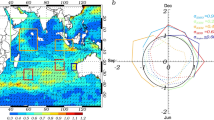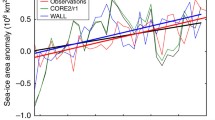Abstract
Over the Southern Ocean the dominant modes of the atmospheric field are known as the Southern Annular Mode (SAM) or Antarctic Oscillation, and the Pacific South American (PSA) pattern. Statistical analysis of sea surface wind (SSW) from satellite observation revealed two leading modes of SAM-like and PSA patterns. In the high latitudes, the SAM-like pattern of the SSW had a large amplitude over the Bellingshausen Basin and Australian-Antarctic Basin, with opposite phase between the two basins. On the intraseasonal time scale, large-scale sea surface height (SSH) also had notable variability, showing a basin-scale anti-phase mode over the two basins. To explain the response of oceanic variations to these atmospheric modes, we analyzed the relationship between the dominant modes of wind stress and large-scale SSH on the intraseasonal time scale. The SAM-like pattern of wind stress was correlated with the SSH variation over the two basins. The SSH basin mode was most simply explained by a simple barotropic response to the SAM-like mode of wind stress, with the curl of opposite phase between the two basins. We conclude that the zonal asymmetry of the wind field of the SAM plays an important role in driving the antiphase SSH basin modes.
Similar content being viewed by others
References
Aoki, S. (2002): Coherent sea level response to the Antarctic Oscillation. Geophys. Res. Lett., 29, 1950, doi:10.1029/2002GL015733.
Cai, W. J. and I. G. Watterson (2002): Modes of interannual variability of the Southern Hemisphere circulation simulated by the CSIRO climate model. J. Climate, 15, 1159–1174.
CLS (2006): SSALTO/DUACS User Handbook: (M)SLA and (M)ADT Near-Real Time and Delayed Time Products (edition 1.5). CLS-DOS-NT-06.034, CLS Space Oceanography Divisin, Toulouse, France, 47 pp.
Fu, L.-L. (2003): Wind-forced intraseasonal sea level variability of the extratropical oceans. J. Phys. Oceanogr., 33, 436–449.
Fukumori, I., R. Raghunath and L.-L. Fu (1998): The nature of global large-scale sea level variability in relation to atmosphere forcing: A modeling study. J. Geophys. Res., 103, 5493–5512.
Ghil, M. and K. Mo (1991): Intraseasonal oscillation in the global atmosphere, Part II: Southern Hemisphere. J. Atmos. Sci., 48, 780–790.
Hirose, N., I. Fukumori, V. Zlotnicki and R. M. Ponte (2001): Modeling the highfrequency barotropic response of the ocean to atmospheric disturbances: Sensitivity to forcing, topography, and friction. J. Geophys. Res., 106, 30,987–30,995.
Hughes, C. W., P. L. Woodworth, M. P. Meredith, V. Stepanov, T. Whitworth and A. R. Pyne (2003): Coherence of Antarctic sea levels, Southern Hemisphere Annular Mode, and flow through Drake Passage. Geophys. Res. Lett., 30, 1464, doi:10.1029/2003GL017240.
Kidson, J. W. (1991): Intraseasonal variation in the Southern Hemisphere Circulation. J. Climate, 4, 939–953.
Kidson, J. W. (1999): Principal modes of Southern Hemisphere low-frequency variability obtained from NCEP-NCAR reanalysis. J. Climate, 12, 2808–2830.
Kiladis, G. N. and K. C. Mo (1998): Interannual and intraseasonal variability in the Southern Hemisphere. Meteor. Monogr., 49, Amer. Meteor. Soc., 307–336.
Koblinsky, C. J. (1990): The global distribution of f/H and the barotropic response of the ocean. J. Geophys. Res., 95, 3213–3218.
Kubota, M., N. Iwasaka, S. Kizu, M. Konda and K. Kutsuwada (2002): Japanese Ocean Flux data sets with Use of Remote sensing Observations (J-OFURO). J. Oceanogr., 58, 213–225.
Kusahara, K. (2007): Dynamics of the wind-driven sea level variation around Antarctica. Ph.D. thesis, Graduate School of Environmental Earth Science, Hokkaido University, 51 pp.
Kutsuwada, K. (1998): Impact of wind/wind-stress field in the North Pacific constructed by ADEOS/NSCAT data. J. Oceanogr., 54, 443–456.
Large, W. G. and S. Pond (1981): Open ocean momentum flux measurements in oderate to strong winds. J. Phys. Oceanogr., 11, 324–336.
Madden, R. A. and P. R. Julian (1971): Detection of 40–50 day oscillation in the zonal wind. J. Atmos. Sci., 28, 702–708.
Meredith, M. P. and C. W. Hughes (2004): On the wind-forcing of bottom pressure at Amsterdam and Kerguelen islands, southern Indian Ocean. J. Geophys. Res., 109, C03012, doi:10.1029/2003JC002060.
Meredith, M. P., P. L. Woodworth, C. W. Hughes and V. Stepanov (2004): Changes in the ocean transport through Drake Passage during the 1980s and 1990s, forced by changes in the Southern Annular Mode. Geophys. Res. Lett., 31, L21305, doi:10.1029/2004GL021169.
Metz, W. (1991): Optimal relationship of large-scale flow pattern and the barotropic feedback due to high-frequency eddies. J. Atmos. Sci., 9, 1141–1159.
Mo, K. (2000): Relationships between low-frequency variability in the Southern Hemisphere and sea surface temperature anomalies. J. Climate, 13, 3599–3610.
Mo, K. and M. Ghil (1987): Statistics and dynamics of persistent anomalies. J. Atmos. Sci., 44, 877–901.
North, G. R., T. L. Bell, R. F. Cahalan and F. J. Moeng (1982): Sampling errors in the estimation of empirical orthogonal functions. Mon. Wea. Rev., 110, 699–706.
Thompson, D. W. J. and J. M. Wallace (2000): Annular modes in the extratropical circulation. Part I: Month-to-month variability. J. Climate, 13, 1000–1016.
Vivier, F., K. A. Kelly and M. Harismendy (2005): Causes of large-scale sea level variations in the Southern Ocean: Analysis of sea level and a barotropic model. J. Geophys. Res., 110, C09014, doi:10.1029/2004JC002773.
Webb, D. J. and B. A. de Cuevas (2002a): An ocean resonance in the southeast Pacific. Geophys. Res. Lett., 29(8), 1252, doi:10.1029/2001GL014259.
Webb, D. J. and B. A. de Cuevas (2002b): An ocean resonance in the Indian sector of the Southern Ocean. Geophys. Res. Lett., 29(14), 1664, doi:10.1029/2002GL015270.
Author information
Authors and Affiliations
Corresponding author
Rights and permissions
About this article
Cite this article
Iijima, Y., Aoki, S. & Kutsuwada, K. The Southern Annular Mode and opposite-phased Basin Mode of the Southern Ocean circulation. J Oceanogr 65, 53–60 (2009). https://doi.org/10.1007/s10872-009-0005-0
Received:
Revised:
Accepted:
Published:
Issue Date:
DOI: https://doi.org/10.1007/s10872-009-0005-0




